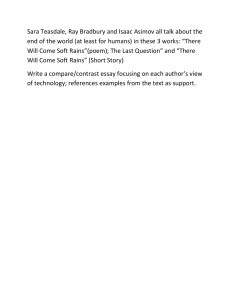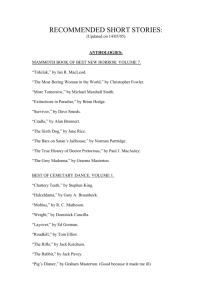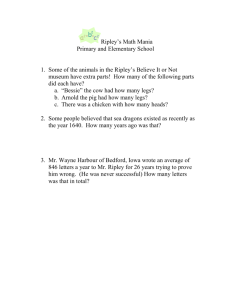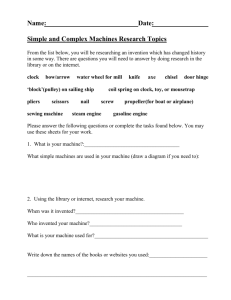Ahead of Their Time
advertisement
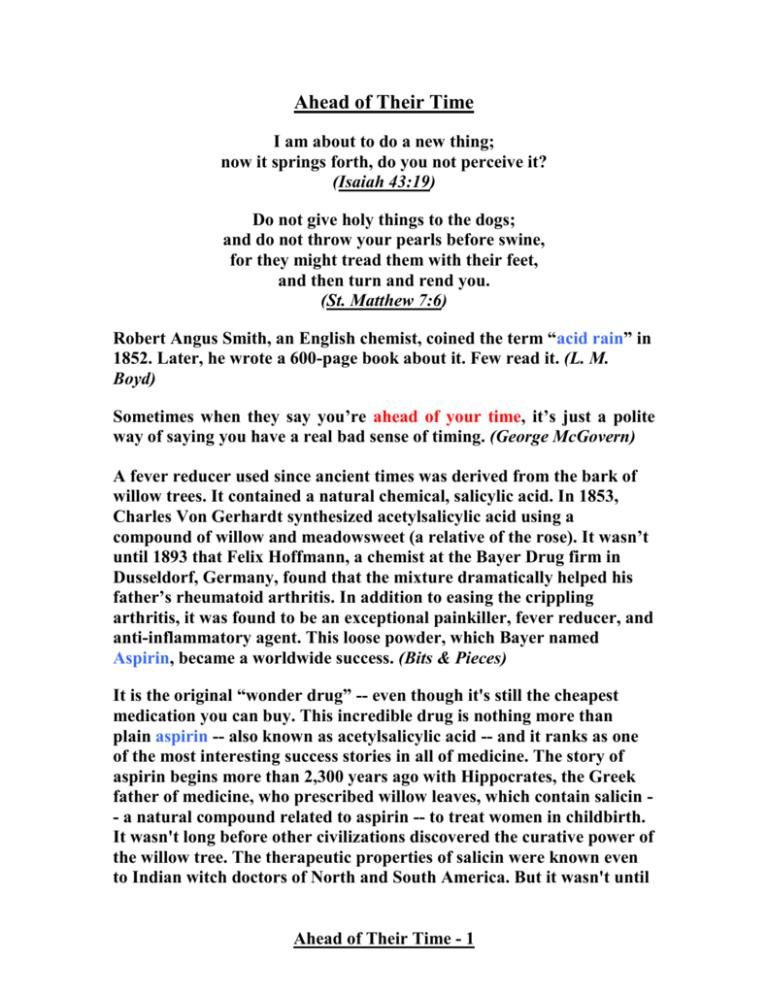
Ahead of Their Time I am about to do a new thing; now it springs forth, do you not perceive it? (Isaiah 43:19) Do not give holy things to the dogs; and do not throw your pearls before swine, for they might tread them with their feet, and then turn and rend you. (St. Matthew 7:6) Robert Angus Smith, an English chemist, coined the term “acid rain” in 1852. Later, he wrote a 600-page book about it. Few read it. (L. M. Boyd) Sometimes when they say you’re ahead of your time, it’s just a polite way of saying you have a real bad sense of timing. (George McGovern) A fever reducer used since ancient times was derived from the bark of willow trees. It contained a natural chemical, salicylic acid. In 1853, Charles Von Gerhardt synthesized acetylsalicylic acid using a compound of willow and meadowsweet (a relative of the rose). It wasn’t until 1893 that Felix Hoffmann, a chemist at the Bayer Drug firm in Dusseldorf, Germany, found that the mixture dramatically helped his father’s rheumatoid arthritis. In addition to easing the crippling arthritis, it was found to be an exceptional painkiller, fever reducer, and anti-inflammatory agent. This loose powder, which Bayer named Aspirin, became a worldwide success. (Bits & Pieces) It is the original “wonder drug” -- even though it's still the cheapest medication you can buy. This incredible drug is nothing more than plain aspirin -- also known as acetylsalicylic acid -- and it ranks as one of the most interesting success stories in all of medicine. The story of aspirin begins more than 2,300 years ago with Hippocrates, the Greek father of medicine, who prescribed willow leaves, which contain salicin - a natural compound related to aspirin -- to treat women in childbirth. It wasn't long before other civilizations discovered the curative power of the willow tree. The therapeutic properties of salicin were known even to Indian witch doctors of North and South America. But it wasn't until Ahead of Their Time - 1 1826 that the magic ingredient was finally isolated by two Italian chemists. And then in 1853, a French chemist produced acetylsalicylic acid in his laboratory. Amazingly, the drug was shelved for decades -because no one knew what to do with it. Chemists working at the Bayer company in Germany began to experiment with aspirin in the 1890s. But the drug nearly got shelved again -- because the company's head of pharmacology believed it was useless. His own company finally overruled him when aspirin was proved beyond a doubt to be a powerful pain reliever and fever reducer. Bayer began to market aspirin in 1899. The new medicine was immediately hailed as a wonder drug. And it has been relieving aches and pains and swelling and fever ever since. (Maury M. Breecher) In the 1880s, when inventors on both sides of the Atlantic were tinkering with steam-driven and gasoline-powered automobiles, the general public remained largely unimpressed. A German newspaper, reporting on the work of automotive pioneer Karl Benz, asked the question: “Who is interested in such a contrivance so long as there are horses on sale?” (James Meyers, in Mammoth Book of Trivia, p. 196) Johann Sebastian Bach was little known as a composer in his own time and didn't really come into worldwide renown for a hundred years after his death. The man who “found” him and restored him to his pinnacle of musical mastery was Felix Mendelssohn, who began to study him in 1829. (Bernie Smith, in The Joy of Trivia, p. 206) Almost none of Bach’s music attained any widespread fame during his 65-year lifetime, and very little was published. (Reader’s Digest) Beethoven as a child, made such a poor impression on his music teachers that he was pronounced hopeless as a composer. Even Haydn, who taught him harmony for a time did not recognize Beethoven’s potential genius. (Isaac Asimov’s Book of Facts, p. 388) Johann Friedrich von Struensee (1731-1772) was executed in Denmark for crimes against the state - one of those crimes being the fact that he invented the game called Bingo. (Ripley’s Believe It or Not!: Weird Inventions & Discoveries, p. 75) Ahead of Their Time - 2 Norman Thomas, six-time Socialist Party candidate for President of the United States, never polled more than 884,000 popular votes in one election, but his influence on American political and social thought was widely effective. Among the reforms that he early championed and that later were enacted were unemployment compensation and old-age pensions. (Isaac Asimov’s Book of Facts, p. 190) In 280 B.C. the Greek astronomer Aristarchus said the Sun, not Earth, was the center of the Solar System. It was more than 1,800 years before he was proved right. (Pam Beasant, in 1000 Facts about Space, p. 29) Not even champagne was an instant success. Dom Perignon invented it in 1714. He loved it at first taste. But it was another 56 years before the French generally decided they liked it, too. (L. M. Boyd) On May 8, 1886, Atlanta pharmacist Dr. John Pemberton combined a caramel-colored syrup with coca leaf extract and carbonated water to make a fizzy drink his partner dubbed Coca Cola. Beyond Atlanta, it was a tough sell. “It has been introduced in other towns but never grew in popular favor,” said a soda fountain operator in 1889. Today, Coke is distributed in some 200 nations. (Chai Woodham, in Smithsonian magazine) Scientist Charles Babbage died unrecognized for his life's work: designing a mechanical computer in the mid-1800s. Not till thirty years after his death was the computer pioneer recognized for his genius. (Bob Fenster, in They Did What!?, p. 185) Nicolaus Copernicus (1473-1543) was a Polish astronomer and mathematician. He published a book that said the Sun, not Earth, was the center of the Solar System. His book was officially banned until 1835. (Pam Beasant, in 1000 Facts about Space, p. 28) Denver civic leaders drove Judge Benjamin Barr Lindsey out of town in the 1920s for thinking scandalously far ahead of his time. But when he died during World War II, they put a bronze bust of him in the courthouse and called him Colorado’s greatest citizen for creating a special Denver court for children that became a world model. Not quite 5 feet 5 inches tall, Lindsey was so fierce a fighter for his controversial beliefs that his friend, Theodore Roosevelt, nicknamed him “The Bull Mouse.” Others called him “the little giant” for his work in Denver’s Ahead of Their Time - 3 juvenile court that led to the creation of similar courts for children nationwide and around the world. Flamboyant and irascible, Lindsey insisted that children weren’t capable of committing crimes and would respond to adult trust and kindness. He said children should be rehabilitated, not punished. (Karen Abbott, in Denver Rocky Mountain News) The very first crossword puzzle, containing just 32 clues, appeared in the New York World on December 21, 1913. It had been thought up as a space filler by an expatriate Englishman named Arthur Wynne, who called it a word-cross. It became a regular feature in the World, but nobody else picked it up until April 1924 when a fledging publishing company called Simon and Schuster brought out a volume of crossword puzzles, priced at $1.35. The most venerable papers on both sides of the Atlantic refused for years to acknowledge that the crossword was more than a passing fad. The Times of London held out until January 1930, when it finally produced its first crossword. To salve its conscience at succumbing to a frivolous game, The Times printed occasional crosswords in Latin. Its namesake in New York held out for another decade and did not produce its first crossword until 1942. (Bill Bryson, in The Mother Tongue) Emily Dickinson wrote more than nine hundred poems, only four of which were published during her lifetime. (David Louis, in Fascinating Facts, p. 88) Emily Dickinson wrote 1,700 poems. Seven were published in her lifetime. (Uncle John’s Unstoppable Bathroom Reader, p. 351) On August 6, 1932, Richard Hollingshead Jr. first registered his patent for the drive-in movie theater. Hollingshead was awarded the patent in May 1933, though it was declared invalid in 1950. After the patent was revoked, thousands of drive-ins appeared on the American landscape, reaching a peak of 4,063 in 1958. (MOMENTS IN TIME – The History Channel) On March 31, 1889, the Eiffel Tower was dedicated in Paris. Gustave Eiffel’s tower was greeted with skepticism, as critics argued it would be structurally unsound. Within a few decades, however, the tower came to Ahead of Their Time - 4 be regarded as an architectural masterpiece. (MOMENTS IN TIME – The History Channel) None other than Plato himself dictated that the circle was the perfect form for celestial movement, and for the next two thousand years, astronomers said that planetary orbits were circular -- even though their observations didn’t quite jibe with that. Even Copernicus used circles in his heliocentric model of the universe. Only after much soulsearching did Kepler use the ellipse to describe the heavenly paths. (Roger van Oech, in A Kick in the Seat of your Pants) A wilted flower gave us one of the world’s best-known anesthetics. Although ether was first discovered in 1549, nothing was done with it until 1923 when a British doctor named Lockhardt noticed his carnations wilted when they were exposed to it. He wondered what the gas would do to a human body and tried it on himself. He briefly passed out; when he awoke, he had proved a practical use for the first modern anesthetic. Strangely, Valerius Cordus observed the same phenomenon in 1549, but made no more of it. And in 1842, Dr. Crawford Long revived a patient who had sniffed too much of it, but no one understood its potential as an anesthetic and the gas was used only at parties as a titillation for young socialites. (Ripley’s Believe It or Not!: Book of Chance, p. 212) As late as the sixteenth century, many oculists remained skeptical of eyeglasses. In 1583, Dr. Georg Bartisch of Dresden, one of the most famous oculists of his time, advised patients to do without spectacles. “A person sees and recognizes something better when he has nothing in front of his eyes than when he has something there,” the doctor reasoned. “It is much better that one should preserve his two eyes than that he should have four.” (Denver P. Tarle, A Treasury of Trivia, p. 126) The idea behind FedEx originated in the 1965 term paper Fred Smith wrote for an undergraduate economics class at Yale University. He got a “C” for his efforts. (David Hoffman, in Little-Known Facts about WellKnown Stuff, p. 53) Leonardo da Vinci, the epitome of the renaissance man, even designed a latrine with a flush toilet, ventilation shaft, and a door that would close automatically in the event the previous user was negligent. But Ahead of Their Time - 5 Leonardo’s suggestions went unheeded for centuries. (James Meyers, in Mammoth Book of Trivia, p. 347) So convinced were Americans that it was not in man’s power to fly like the birds, that when the Wright brothers announced that they had successfully flown a power-driven airplane at Kitty Hawk, North Carolina, on December 17, 1903, neither the public nor the press believed them. What’s more, this skepticism lasted an incredible five years, during which time the Wrights made repeated demonstrations of their airplane, which newspaper editors refused to cover, believing the Wrights to be crackpots or charlatans. (James Meyers, in Mammoth Book of Trivia, p. 207) When oil was discovered in the United States, in 1859, gasoline was a useless by-product. It remained so until the development of automobiles. In the early days, far more attention was paid to such byproducts as cylinder oil and engine oil (both lubricants), kerosene, naphtha for cleaning, petroleum jelly for ointments, and paraffin. The first commercial product made from petroleum was rock oil, sold at $1 a bottle as a cure for cholera, corns, toothache, and neuralgia. In 1870, one company turned 70,000 pounds of paraffin into chewing gum. (Isaac Asimov's Book of Facts, p. 288) Two out of five golf balls are colored, now. I say “now” because when they were first introduced commercially in 1928 nobody wanted them. (L. M. Boyd) On December 12, 1899, George F. Grant of Boston, Mass., got Patent No. 638,920 for the world’s first golf tee. But it still was decades later before golfers used ready-made tees. Even when your granddad was a lad, golfers as often as not hand-shaped their tees out of damp dirt. (L. M. Boyd) When Rebecca Wood started touting grains 30 years ago, she says, “I was considered a fringe lunatic. Now my book has won both the Julia Child and the James Beard award.” Wood, who has lived in Colorado most of her life, is the author of The Splendid Grain and often teaches classes around town on her favorite subject. “I’ve been passionate about grains all these years because I feel good when I eat them, and my Ahead of Their Time - 6 students feel good,” she says. (Marty Meitus, in Denver Rocky Mountain News) The first ice-making machine patented in 1851 by Dr. John Gorrie of Apalachicola, Florida, to cool hospital rooms, was a financial failure because it was denounced as “too fantastic” (Ripley’s Believe It or Not!: Weird Inventions & Discoveries) Got a better idea? Chances are that the world may not quite be ready for it yet. Consider some of these discoveries: The incubator was invented by an ingenious physician in 1577 to save his premature baby, who lived to be 80. Yet incubators only came into general use in hospitals this century. Microfilm was used during the siege of Paris in 1870 when minute copies of the London Times were flown in by carrier pigeon. Yet the invention languished until the 1940s when it was rediscovered. The first zip fastener was invented by Whitcomb L. Judson of Chicago in 1891. The modern-day zipper of identical units mounted on parallel tapes was patented in April 1913 by Gideon Sundback, a young Swedish engineer from Hoboken, New Jersey. But it was not until 1930 that the first zippers appeared on Paris dresses and 1935 that zippers on men’s trousers were introduced! S. C. Gilfillan studied the history of 19 inventions that came into general use between 1888 and 1913. He found it took an average 176 years before the idea was actually tried out, another 24 before it became practical and 14 more before it made any money! (Ripley’s Believe It or Not!: Weird Inventions & Discoveries) Some modern inventions were on the shelf for some time before becoming reality: Photography was conceived in 1782 but only came into use in 1838. Television was thought of in 1884 but we first began to tune in 63 years later. Nuclear energy seemed like a good idea in 1919 but only became reality in 1965. Instant coffee was introduced in 1934 but only began to be produced in quantity in 1956. But filter cigarettes were invented in 1953 -- and were on the market in 1955! (Ripley’s Believe It or Not!: Weird Inventions & Discoveries) Nineteenth-century French agricultural chemist Jean Baptiste Boussingault was correct in theorizing that iodine compounds could be the cure for goiter -- but this insight was ignored for over half a century. (Isaac Asimov’s Book of Facts, p. 239) Ahead of Their Time - 7 Among his many other accomplishments, the third president of the United States rewrote the Bible. That might seem a remarkably audacious thing for anyone to do, but it was quite natural for a man of Thomas Jefferson's complex nature. He was a true genius who often got into trouble for refusing to follow the crowd. The United States government bought the book in 1895; they had no doubt that it belonged to the nation. In 1904 Congress published it under the title The Morals of Jesus and gave copies to its members. And commercial printings eventually appeared in bookstores, including editions in 1923, 1940 and 1989. So the book Thomas Jefferson once kept carefully hidden was finally available for anyone to see. (C. Bruce Hunter, in Bible Review) Write of Passage: Author and humorist Garrison Keillor began writing for The New Yorker in 1970. “Actually, I’ve written for The New Yorker since I was in high school,” he has said, “though they weren’t aware of it at the time.” (Reader’s Digest, Quoted by Robert A. Carter, in Publishers Weekly) Marconi was committed to an insane asylum for suggesting voices could be transmitted through air without wires. (Robert Wood, in Along The Path) When Herman Melville moved his family to a farm in 1850, the author thought he would make a good living as a farmer and writer. He failed at both. His whaling saga, Moby Dick, was rejected by critics and readers, and his farm went bankrupt. Melville gave up, moved to New York and became a customs official, dying in obscurity. Not ‘til thirty years after his death was Moby Dick recognized as an American masterpiece. (Bob Fenster, in They Did What!?, p. 182) In Herman Melville’s lifetime, Moby Dick only sold 50 copies. (L. M. Boyd) “The Crucifixion of Peter,” a fresco in the Cappella Paolina of the Vatican Palace, was painted more than four hundred years ago by Michelangelo. It is the least known and for centuries was regarded as the least admired of all his works. Now art historians and other experts are taking another look. And lo and behold! They’ve decided it’s one of the old boy’s greatest! (Bernie Smith, in The Joy of Trivia, p. 209) Ahead of Their Time - 8 If it is true that we are approaching a moneyless society, then some of us are ahead of our time. (Kirk Kirkpatrick) The world-record price for a painting was smashed Monday when Vincent van Gogh's “Sunflowers” sold for 24,750,000 pounds -- more than $39.9 million -- at Christie's auction house in London. The painting was bought by an anonymous foreign buyer in a battle between two bidders conducted over the telephone in Christie's auction room. The $39,921,750 price made “The Sunflowers” the most expensive bunch of flowers ever sold, working out to almost $3 million a bloom. The sad irony is that van Gogh, penniless and unknown, committed suicide in 1890 in despair at age 37. He had sold only one painting in his lifetime. (Baltimore Sun, March 31, 1987) In the early 1700s, the French physicist Rene de Reaumur discovered the concept of making paper from wood after watching wasps chewing wood, turning it to pulp with their saliva, and spreading it on their nests, where it dried into “paper” when exposed to air. But the idea was not put into practical use until 1852, when the first wood-grinding machine for pulverizing wet wood (invented by a German weaver, Frederic Keller) was employed in the production of the first newsprint. (Isaac Asimov’s Book of Facts, p. 189) In the Sixteenth Century, the physician Andreas Vesalius was denounced as an imposter and heretic because of his discoveries in the field of human anatomy. His theories were accepted after his death but, at the time, his career was ruined, and he was forced to flee from Italy. (G. Edward Griffin, in World Without Cancer) A certain politician sometime back advocated unemployment insurance, minimum wage laws, old age pensions and health insurance. In the 1920s and 1930s, this fellow, Norman Thomas, ran for the presidency six times on such platform pranks, but was ever defeated. Too radical, it was said at the time. (L. M. Boyd) Cyrus McCormick’s reaper was considered worthless by his creditors when he went bankrupt after the Panic of 1837. Although he lost his farm, and everything he owned was put up for sale, no one considered the reaper a marketable item, and he got to keep it. (Isaac Asimov’s Book of Facts, p. 58) Ahead of Their Time - 9 In 1843, Oliver Wendell Holmes Sr. campaigned for basic sanitation in hospitals. But this clashed with social ideas of the time and met with widespread disdain. Charles Meigs, a prominent American obstetrician, retorted, “Doctors are gentlemen, and gentlemen’s hands are clean.” (Liza Lentini & David Mouzon, in Discover magazine) Less than $3,000 is what Austrian Franz Schubert's musical compositions earned him during his life. He lived 31 years, dying in 1828, and heard few of his orchestral works performed. (L. M. Boyd) Socrates was required to drink hemlock to end his life after being found guilty of corrupting the youth of Athens. (Noel Botham, in The Best Book of Useless Information Ever, p. 207) When the United States Post Office issued the first federal stamps 150 years ago, the public response was distinctly, well, lukewarm. No brass bands played. No first day covers were issued. Hardly anybody bothered to use the stamps, though they bore the images of Ben Franklin and George Washington. During the first five years after federal stamps were introduced, less than 1 percent of America’s mail made use of them. ((John Ross, in Smithsonian magazine) In 435 B.C., the Greek philosopher Anaxagoras suggested that the sun was not just a small glowing circle of light. He maintained that it was a glowing rock a hundred miles across. For that outrageous statement, he was exiled from Athens. (Isaac Asimov’s Book of Facts, p. 399) Tea: When it first got to America, nobody knew what to do with it. Some battered and salted the little dried leaves and munched on them as special treats on cold New England nights. Others just boiled it all for an hour or more and drank the bitter, black brew without sugar or milk. It was said that this plant could raise spirits, soothe nerves, give comfort, and other cures. (Derric Johnson, in The Wonder of America, p. 126) When Alexander Graham Bell invented the telephone in 1876, it did not ring off the hook with calls from potential backers. After making a demonstration call, President Rutherford Hayes said, “That’s an amazing invention, but who would ever want to use one of them?” (Jack Canfield, in A 2nd Helping of Chicken Soup, p. 253) Ahead of Their Time - 10 Millions scoffed when, almost five decades ago, Nikola Tesla spoke of death rays and an electronic “Chinese wall” of defense around America created out of radio waves; now, billions of dollars are being spent on the conceptually similar “Star Wars” defense. (Stephen S. Hall, in Smithsonian magazine) Henry David Thoreau (1817-1862) wrote 20 volumes, yet he never earned a living by his pen. His first book sold only 219 copies and his famed “Walden” did not sell out its first edition of 2,000 copies for 5 years. (Ripley’s Believe It or Not!: Book of Chance) Thoreau - only two works published in lifetime. (World Features Syndicate) Tupperware, 1946: Another amazing American invention; how would we have survived without it? Earl Tupper designed a plastic box with an airtight seal to be used in fridges – but at first no one was much interested. Then he met ace saleswoman Brownie Wise. She suggested Tupperware parties – where hostesses demonstrated their use, then sold them. The queen, who uses Tupperware at Buckingham Palace, will always be grateful. (Hunter Davies’ Book of Lists, p. 105) In 1874, the first practical typewriter was placed on sale by E. Remington and Sons. You might imagine that the first Remingtons were scooped up by clever businessmen as fast as they could be manufactured. Not true. Most businessmen couldn’t see the advantage of a machine only slightly faster than handwriting that cost, in the words of one, “a thousand times as much as a pen.” As late as 1881, Remington was selling only 1,200 machines a year. (Denver P. Tarle, in A Treasury of Trivia, p. 49) Vincent van Gogh sold only one painting in his whole life – and that was to his brother. (David Hoffman, in Little-Known Facts about Well-Known Stuff, p. 63) Vincent van Gogh’s portrait of Dr. Rey, painted while he was in a sanatorium and given to the doctor as a token of thanks, was found in a crack in a chicken coop. Van Gogh sold only two paintings in his lifetime, for a total of $84. (Ripley’s Believe It or Not!: Book of Chance, p. 38) Ahead of Their Time - 11 The artist Vincent van Gogh is said to have sold only one painting in his entire lifetime. (Mulligan Stew ‘n Chestnuts, Too newsletter) In the winter of 1535, when the French explorer Jacques Cartier found his ships frozen in the ice off the St. Lawrence River, scurvy began to take its deadly toll. Out of a crew of one hundred and ten, twenty-five already had died, and most of the others were so ill they weren’t expected to recover. And then a friendly Indian showed them the simple remedy. Tree bark and needles from the white pine--both rich in ascorbic acid, or vitamin C -- were stirred into a drink which produced immediate improvement and swift recovery. Upon returning to Europe, Cartier reported this incident to the medical authorities. But they were amused by such “witch-doctor cures of ignorant savages” and did nothing to follow it up. Yes, the cure for scurvy was known. But, because of scientific arrogance, it took over two hundred years and cost hundreds of thousands of lives before the medical experts began to accept and apply this knowledge. Finally, in 1747, John Lind, a young surgeon’s mate in the British Navy discovered that oranges and lemons produced relief from scurvy, and recommended that the Royal Navy include citrus fruits in the stores of all its ships. (G. Edward Griffin, in World Without Cancer, p. 49) On January 1, 1869, Thomas Edison received his first patent. It was for a vote recorder, with which the member of a legislature could push a button marked “nay” or one marked “aye” on his desk. At once his vote would show up on an electrified board on the wall. Today legislatures everywhere use a machine of this sort. But in the mid-nineteenth century, American politicians were not yet ready to expose their votes on a screen. (Milton Lomask, in Great Lives, p. 50) Elizabeth Robb Douglas invented the collapsible voting booth in 1905 before women even had the right to vote. Her invention led to the formation of Douglas Manufacturing Company in Crete, Nebraska, which keeps elections running smoothly. (American Profile magazine) Thomas Edison’s first patented invention was a voting machine, designed in the 1860s and completely uninteresting to the customers for whom it was intended. It took many years before it was considered acceptable by American politicians. (Isaac Asimov’s Book of Facts, p. 147) Ahead of Their Time - 12 Joseph Semmelweiss, the 19th century Hungarian physician, felt that doctors could reduce disease by washing their hands in chlorinated lime water before inspecting their patients. His colleagues -- because they thought that doctors were close to God -- strongly resented his suggestion that they were ‘carrying death around on their hands,’ and denounced him. The later discovery of bacteria proved Semmelweiss correct. (Roger van Oech, in A Kick in the Seat of your Pants) Sir John Harrington invented the first valve-controlled water closet in 1596. Sir Thomas Crapper came out with his flush model in 1837. Henry Wadsworth Longfellow installed one in his home in 1840. Wasn’t until then the public got interested. For 244 years, people thought such an outlandish thing was too fancy for them. (L. M. Boyd) Benjamin Franklin once wrote an essay on the possibility of waterskiing. (Uncle John’s Unstoppable Bathroom Reader, p. 402) Yesterday’s weirdness is tomorrow’s reason why. (Hunter S. Thompson) Another man was regarded as moderately deranged by most railroad executives when he suggested a train could be stopped - using wind. Yet George Westinghouse persevered and finally sold to the industry what is now known as the Westinghouse Air Brake, a standard feature on American trains. (Dr. Charles Dickson, in New Realities magazine) In the years immediately following the Wright Brothers’ first airplane flight, most magazine and journal editors regarded the Wrights’ story as so much science fiction, refusing to believe that a man had actually flown at Kitty Hawk. Amazingly enough, the first eyewitness account of a Wright Brothers’ flight was published in a magazine called Gleamings in Bee Culture, after its editor witnessed a flight of the Wrights’ second machine, Flyer II. (Denver P. Tarle, in A Treasury of Trivia, p. 57) The modern zipper, the talon slide fastener, was invented in 1913 but didn’t catch on until the first dresses incorporating it appeared in the 1930s. (Joe Edelman & David Samson, in Useless Knowledge, p. 104) ************************************************************* Ahead of Their Time - 13

